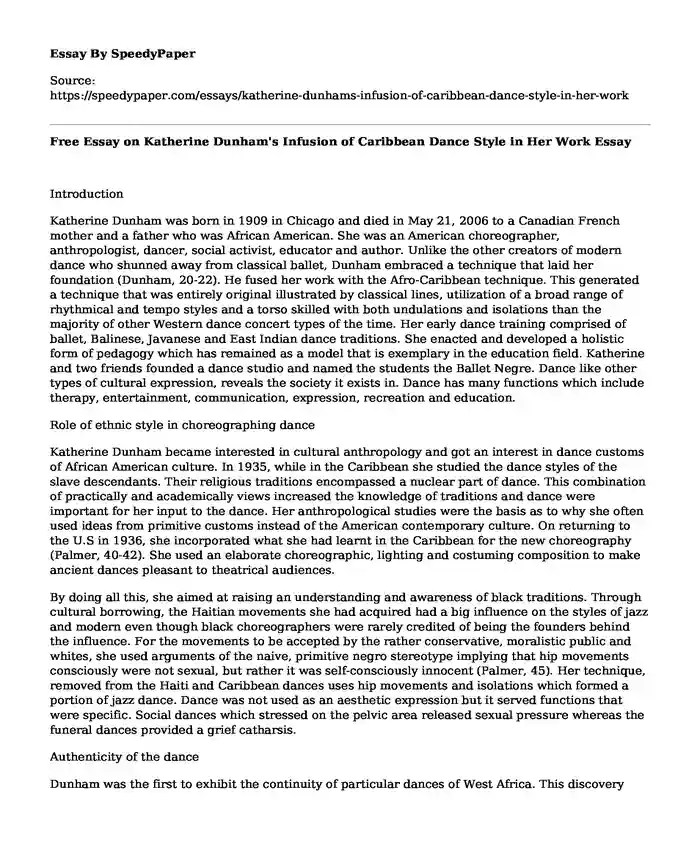Introduction
Katherine Dunham was born in 1909 in Chicago and died in May 21, 2006 to a Canadian French mother and a father who was African American. She was an American choreographer, anthropologist, dancer, social activist, educator and author. Unlike the other creators of modern dance who shunned away from classical ballet, Dunham embraced a technique that laid her foundation (Dunham, 20-22). He fused her work with the Afro-Caribbean technique. This generated a technique that was entirely original illustrated by classical lines, utilization of a broad range of rhythmical and tempo styles and a torso skilled with both undulations and isolations than the majority of other Western dance concert types of the time. Her early dance training comprised of ballet, Balinese, Javanese and East Indian dance traditions. She enacted and developed a holistic form of pedagogy which has remained as a model that is exemplary in the education field. Katherine and two friends founded a dance studio and named the students the Ballet Negre. Dance like other types of cultural expression, reveals the society it exists in. Dance has many functions which include therapy, entertainment, communication, expression, recreation and education.
Role of ethnic style in choreographing dance
Katherine Dunham became interested in cultural anthropology and got an interest in dance customs of African American culture. In 1935, while in the Caribbean she studied the dance styles of the slave descendants. Their religious traditions encompassed a nuclear part of dance. This combination of practically and academically views increased the knowledge of traditions and dance were important for her input to the dance. Her anthropological studies were the basis as to why she often used ideas from primitive customs instead of the American contemporary culture. On returning to the U.S in 1936, she incorporated what she had learnt in the Caribbean for the new choreography (Palmer, 40-42). She used an elaborate choreographic, lighting and costuming composition to make ancient dances pleasant to theatrical audiences.
By doing all this, she aimed at raising an understanding and awareness of black traditions. Through cultural borrowing, the Haitian movements she had acquired had a big influence on the styles of jazz and modern even though black choreographers were rarely credited of being the founders behind the influence. For the movements to be accepted by the rather conservative, moralistic public and whites, she used arguments of the naive, primitive negro stereotype implying that hip movements consciously were not sexual, but rather it was self-consciously innocent (Palmer, 45). Her technique, removed from the Haiti and Caribbean dances uses hip movements and isolations which formed a portion of jazz dance. Dance was not used as an aesthetic expression but it served functions that were specific. Social dances which stressed on the pelvic area released sexual pressure whereas the funeral dances provided a grief catharsis.
Authenticity of the dance
Dunham was the first to exhibit the continuity of particular dances of West Africa. This discovery was significant as it was cognized in the dancing act, through bodily immersion in the peoples communal dances. Today we realize from modern scholarship the essence of the early trans-Atlantic presentation connections of Dunham for the African people, whether in Africa or in the diaspora, it signifies the enacting of the instantaneous social context, philosophical and historical worldview. These strategies were well understood by Dunham which were fixed within the African performance. This was evident in the Koromantee and Lagya dances which she most treasured (Tafferner-Gulyas, 50)
Literature review
In my own views am pleased with the uniqueness of the ballet dance of Katherine Dunham. This is because when she was coming up with a dance it was not just for the sake of pleasing the audience but it was meant to educate especially about the discrimination the Africans were being subjected to. As compared to film as a form of art the message can be exaggerated as some editing is done. The emotions of the participants are not explicitly expressed as most of them are vague. Compared to film, Ballet needs one to give a wholeheartedly performance. The ballet dance is contributing to the forms of art since some academic traits like the use of anthropology is incorporated in getting ideas of composing the dances and they are meant to educate.
Conclusion
In conclusion, Katherines career and life are miraculous and perhaps the most influential and best known founder of the black dance. She wanted to show that Africa- Caribbean and African American styles are powerful and related part of dancing in America. Most of her dances were put together by thus were authentic.
Work cited
Dunham, Katherine, Veve A. Clark, and Sarah E. Johnson.
Kaiso!: Writings by and About Katherine Dunham. Madison: University of Wisconsin Press, 2005.
Palmer, Colin A. Encyclopedia of African-American Culture and History: The Black Experience in the Americas. Detroit, Mich: Macmillan Reference USA, 2006.
Tafferner-Gulyas, Viktoria. Caribbean Traditions in Modern Choreographies: Articulation and Construction of Black Diaspora Identity in L'ag'ya by Katherine Dunham. , 2014.
Cite this page
Free Essay on Katherine Dunham's Infusion of Caribbean Dance Style in Her Work. (2017, Sep 03). Retrieved from https://speedypaper.com/essays/katherine-dunhams-infusion-of-caribbean-dance-style-in-her-work
Request Removal
If you are the original author of this essay and no longer wish to have it published on the SpeedyPaper website, please click below to request its removal:
- Essay Example on Corporate Social Responsibility (CSR) of Walmart
- Anthropology Essay Sample: The Machine Zone
- Essay Example in Hispanic Culture History
- Essay Sample on Colonial Literature
- Essay Example on the Topic of Communication and Fashion
- Essay Example Dedicated to Airport Safety
- Free Essay Example - Responses to Students
Popular categories





